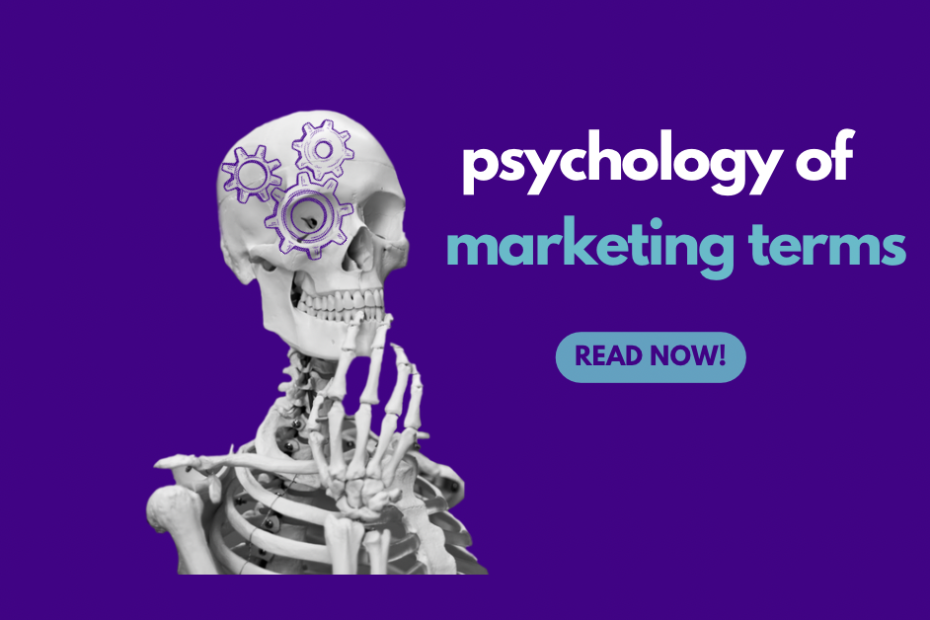It’s important for small businesses to have a basic understanding of the psychology of marketing terms. In the world of marketing, (or anything really) the power of words cannot be underestimated. The careful selection and use of marketing terms can have a profound impact on customer behaviour and decision-making. Understanding the psychology behind these terms is crucial for any small business looking to create effective campaigns and connect with their target audience.

Photo David Matos.
The Power of Persuasion
One of the key aspects of marketing is persuasion. Marketers aim to influence consumer behaviour and convince them to take a desired action, whether it’s making a purchase, signing up for a service, or subscribing to a newsletter. The choice of words used in marketing materials plays a significant role in this process.

Image Tengyart
1. Emotional Appeal
Emotions are powerful motivators, and marketers often leverage this using emotionally charged terms. Words like “amazing,” “exciting,” “life-changing,” and “unforgettable” evoke positive emotions and create a sense of desire or urgency. By tapping into consumers’ emotions, marketers can establish a deeper connection and increase the likelihood of conversion.
Nike’s “Just Do It” slogan is one of the most iconic examples of emotional marketing. The slogan taps into people’s desire to achieve their goals and overcome challenges.
Dove’s “Real Beauty” campaign celebrated women of all shapes, sizes, and ethnicities. This campaign resonated with women because it made them feel seen and valued.

Photo Adam Jang
2. Social Proof
Humans are social creatures, and we often look to others for guidance when making decisions. Marketing terms that highlight social proof, such as “best-selling,” “top-rated,” or “trusted millions,” tap into our innate desire to follow the crowd. By emphasizing popularity or endorsement from others, marketers can build trust and credibility, making their products or services more appealing.
McDonald’s “Big Mac” campaign featured the phrase “Billions and Billions Served.” This phrase created a sense of social proof suggesting that the Big Mac was a popular and loved product.
Customer Reviews and Testimonials allow customers to share their opinions. This feature provides social proof showing that other people have had positive experiences with the product or services.
3. Scarcity and Exclusivity
The fear of missing out (FOMO) is a powerful psychological driver. Marketing terms like “limited edition,” “exclusive offer,” or “while supplies last” create a sense of scarcity and urgency. When consumers believe that a product or opportunity is scarce or exclusive, they are more likely to act quickly to avoid missing out on the perceived benefits.
Apple’s “Limited Edition” products are always in high demand because they are not available for very long. This creates a sense of scarcity and urgency that motivates consumers to buy. Groupon’s “Deals of the Day” are only available for a limited time.
A local clothing label created a sense of exclusivity offering a limited-edition clothing line. This creates a sense of urgency that encourages people to act quickly.
However, creating a false sense of scarcity can have a negative effect on your brand. For instance, if you claim that an offer ends in 24 hours, but it remains available for weeks afterwards potential customers may not perceive your brand as credible or trustworthy. In fact they may perceive your brand as desperate! So if you are creating an offer based on scarcity then you need to stick to it and not keep extending the offer.
4. Personalisation
In today’s digital age, consumers expect personalised experiences. Marketing terms that convey a sense of individuality and customisation can be highly effective. Words like “tailored,” “custom-made,” or “personalised recommendations” make consumers feel seen and understood, increasing their engagement and loyalty. Interactive video is on the rise for the same reason.
Netflix’s “Recommendations” feature suggests movies and TV shows that are tailored to each user’s individual preferences. This personalisation makes consumers feel like they are getting a tailored experience from the platform.
A local bookstore might use customer data to send personalised book recommendations to their email subscribers.
Framework for Small Businesses to Offer Personalisation and Customisation
1. Understand Your Customers
- Gather customer data through surveys, feedback forms, and website analytics.
- Analyse customer data to identify patterns, preferences, and pain points.
- Segment your customer base into groups with similar characteristics.
2. Identify Personalisation and Customisation Opportunities
- Analyse customer interactions to identify areas where personalisation or customisation can enhance the experience.
- Consider product features, marketing messages, and customer service interactions.
- Prioritise opportunities based on their potential impact on customer satisfaction and loyalty.
3. Develop Personalisation and Customisation Strategies
- Use customer data to personalise marketing messages, product recommendations, and website content.
- Offer product customisation options, such as colour choices, size variations, and engraving services.
- Implement personalised customer service interactions, such as addressing customers name and referencing their purchase history.
The Impact of Framing
Beyond the specific choice of words, the way marketing messages are framed can also influence consumer perception and decision-making.
1. Positive Framing
Positive framing focuses on the benefits and gains associated with a product or service. Terms like “improve,” “enhance,” “gain,” or “achieve” highlight the positive outcomes consumers can expect. By emphasizing the potential rewards, marketers can create a sense of optimism and motivation.
Car commercials often use positive framing highlighting the benefits of owning a new car, such as safety, comfort, and status.
2. Negative Framing
On the other hand, negative framing highlights the potential losses or problems that consumers may face if they don’t take action. Terms like “prevent,” “avoid,” “eliminate,” or “stop” tap into consumers’ fear of negative outcomes. By highlighting the negative consequences of inaction, marketers can create a sense of urgency and drive action.
An example might be “Protect your business from costly cyberattacks with our robust cybersecurity solutions.”
This framing highlights the potential financial losses that small businesses could face if they don’t have adequate cybersecurity measures in place. It taps into their fear of financial ruin and motivates them to take action to protect their businesses.
However, it’s crucial to strike a balance between highlighting the potential risks and emphasising the positive outcomes of taking action. Using too much negative framing can create unnecessary anxiety and discourage action, while excessive positive framing may not convey the urgency of addressing potential problems.
3. Comparative Framing
Comparative framing involves comparing a product or service to alternatives in the market. Terms like “better than,” “superior to,” or “more cost-effective” position the offering as the preferred choice. By highlighting the advantages over competitors, marketers can sway consumer preferences. eg. Smartphone company ads often compare their products to the latest iPhones highlighting their unique features or superior performance.
Smartphone company ads often compare their products to the latest iPhones highlighting their unique features or superior performance. These ads from over 5 years ago maybe more do exactly that.
Remember.
The psychology of marketing terms is a fascinating field that delves into the intricacies of human behaviour and decision-making. By understanding how words and framing impact consumer perception, small businesses can craft compelling messages that resonate with their target audience. Whether it’s appealing to emotions, leveraging social proof, creating a sense of scarcity, personalising experiences, or framing messages in a positive or negative light, the power of marketing terms should never be underestimated. So next time you’re crafting a marketing material be it in print or digital remember the psychology behind the words you choose, and take notice of the results.
If all this is too much for you or just thinking about it causes you angst talk to us this is what we do!

Pingback: Busting the Hype: Unveiling the Most Annoying Marketing Buzzwords -
Comments are closed.